Why is Corporate Website Design Crucial for Your Business?
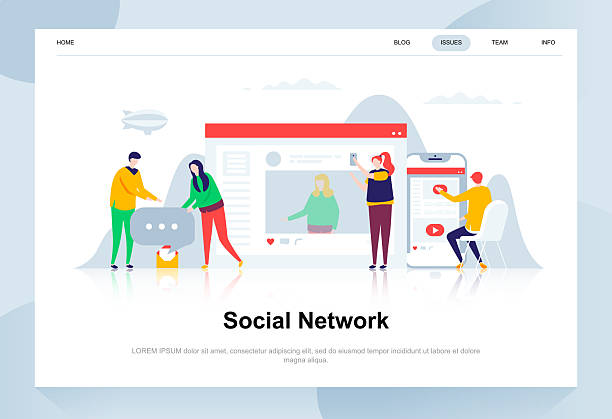
Today, in the fast-paced digital world, having a professional #corporate_website is not merely an option, but a vital and strategic necessity for the survival and growth of any business.
This online platform acts as a 24-hour ambassador for your brand and will be the first point of contact for many potential customers, business partners, and even job-seeking talents with your organization.
An effective and efficient #corporate_website_design not only enhances your credibility and market position but also helps your company stand out clearly and be recognizable amidst today’s fierce competition.
This website provides a suitable platform for comprehensive and organized presentation of your services, products, company history, values, and organizational culture.
With a corporate website, you will be able to connect with your audience worldwide 24 hours a day, 7 days a week, even when your sales or support team is not working.
This makes accessing your information much easier for customers and provides a seamless user experience, ultimately leading to greater satisfaction.
Corporate website design goes beyond displaying contact information or an online brochure; this website should be able to tell your brand’s story in a compelling and attractive manner.
It should also provide features such as smart contact forms, rich image and video galleries, an active news and educational articles section, and even the possibility for online booking or event registration.
The ultimate goal is to create a powerful online presence that not only conveys information clearly and quickly but also encourages customers to actively engage and take desired actions (such as purchasing, contacting, or registering).
Your website is a powerful tool for executing #digital_marketing campaigns, attracting high-quality leads, and reducing traditional marketing costs.
This investment not only significantly increases your brand’s visibility in the online space but also greatly contributes to the #sustainable_growth and long-term development of your business.
The importance of corporate website design has become more evident than ever in the present era, recognized as the cornerstone of all modern marketing strategies and customer communication.
This step will be the first and most crucial in your journey toward online success and the digitalization of your business activities.
Without a professional and optimized website, your company will miss countless opportunities in the digital world and fall behind in the competition.
So, it’s time to consider improving or creating your online platform and benefit from its countless advantages.
These explanations comprehensively illustrate the strategic and vital importance of this topic.
This is a valuable educational lesson for any startup or developing business looking to strengthen its market position.
Are you dissatisfied with the low conversion rate of visitors to customers on your e-commerce site?
Solve this problem forever with professional e-commerce website design by Rasaweb!
✅ Increase visitor-to-customer conversion rate
✅ Create an excellent user experience and build customer trust
⚡ Get free consultation
Key Elements in Designing a Successful Corporate Website
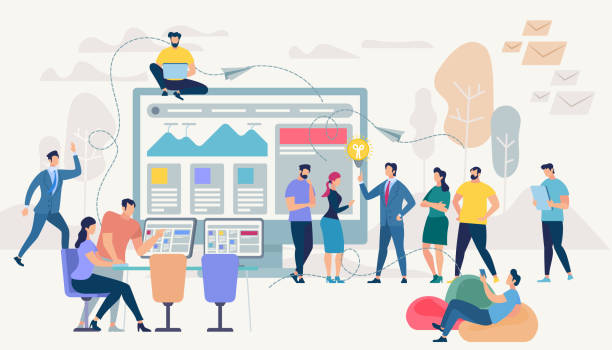
For a corporate website design to be truly successful and meet your business objectives, special and precise attention must be paid to several key and fundamental elements.
The first and perhaps most important element is #responsive_design, which ensures the correct display of the website on all devices.
Your website must be displayed perfectly and flawlessly on various screen types, including desktop computers, laptops, tablets, and smartphones with different sizes and resolutions, in the best possible way.
This not only significantly improves user experience (UX) but is also vital for SEO and receives higher rankings from search engines, as Google prioritizes mobile-friendly websites.
The second essential element is #easy_and_intuitive_navigation, which allows users to navigate the site without confusion.
Users should be able to easily and with minimal effort find the information they need in every section of your website.
Using clear menus, a logical page structure, distinct categories, and relevant and meaningful internal links all contribute to improved navigation and reduce the bounce rate.
The third very important point is #high-quality_and_relevant_content, which forms the backbone of any successful website.
Your content must be valuable, fresh, accurate, engaging, and unique to attract and involve your audience.
This includes persuasive texts, high-quality images, explanatory videos, and any other type of media that provides comprehensive and useful information about your company, products, or services.
Engaging content encourages users to stay longer on your website, visit other pages, and even share it with others, which is a positive signal for search engines.
The fourth element is #fast_website_page_loading_speed.
In today’s world where users are impatient, no user wants to wait a long time for a web page to load.
Optimizing images (compressing size without losing quality), minifying code, using caching, and choosing a reliable and high-speed hosting provider significantly help increase loading speed.
This factor also has a significant direct impact on user experience and search engine rankings.
The fifth element is #clear_call-to-action (CTA).
After users visit and browse information, you must clearly and simply tell them what the next step is and what action is expected of them, such as “Contact us for a free consultation”, “View product catalog”, or “Request an online demo”.
The sixth item is #website_security and user data protection.
Using the secure HTTPS protocol, installing an SSL certificate, regularly updating security systems, and protecting against DDoS attacks are essential for safeguarding user data and preventing cyber intrusion.
These guidelines are specialized and must be carefully considered for every #corporate_website_design project to create a powerful #business_website.
This is a comprehensive and specialized #guide for improving your online presence and increasing the efficiency of your company’s online platform.
Comprehensive Stages of Corporate Website Design from Idea to Implementation
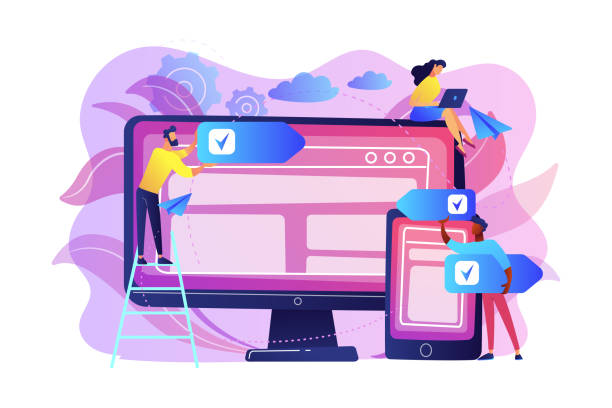
The corporate website design process is a systematic, step-by-step journey that begins with precise and strategic planning and continues with launch, maintenance, and continuous optimization.
A complete and comprehensive understanding of these stages is vital and unavoidable for any company intending to develop or improve its online platform, to maximize its investment.
The first stage and cornerstone of this process is comprehensive #research_and_planning.
In this initial step, core business objectives, target audiences (by creating personas), competitors and their strengths and weaknesses, as well as the website’s technical and functional requirements, are meticulously identified and analyzed.
This also includes defining Key Performance Indicators (KPIs), future content strategies, and initial SEO planning.
A precise and complete #analysis at this stage lays the foundation for a successful and sustainable project and prevents resource wastage in subsequent stages.
The second stage is #user_interface_and_user_experience_design (UI/UX Design), which blends aesthetics and functionality.
In this stage, the website’s visual designs, including wireframes, mockups, and interactive prototypes, are created.
The main focus is on attractive visual layout, user-friendly and easy navigation, and overall aesthetics to ensure the website is both visually appealing and practical and usable.
The goal is for users to easily and without confusion navigate the site and access the information they need.
The third stage is #development_and_coding, which transforms designs into reality.
After final approval of the designs, developers begin coding the front-end (what the user sees) and back-end (behind-the-scenes systems) of the website.
This includes implementing all required functionalities, creating a database, and integrating with other systems such as CRM, ERP, or online payment systems.
It is at this stage that the website’s technical and functional structure takes shape, and your #business_website_design comes to fruition.
The fourth stage is #content_creation, which is considered the beating heart of any website.
At this time, rich and optimized textual content, high-quality images, and engaging videos, which were planned in the initial stages, are produced and placed on the website.
Content must be both engaging and informative for users and optimized for search engines to ensure the website’s visibility.
The fifth stage is extensive #testing_and_optimization.
Before the final launch, the website is thoroughly tested to identify and resolve technical, security, functional, and user experience issues.
This stage includes compatibility tests with various browsers and devices, speed tests, form and link functionality tests, and load testing.
The sixth and final stage is #launch (Deployment).
After full assurance of the correctness and functionality of all sections, the website is hosted on a server and becomes publicly accessible.
These stages are performed expertly and continuously, and each plays a vital role in completing the #corporate_website_design project and ensuring its success.
This is a complete tutorial on the comprehensive process of #company_website_development that every organization should follow.
| Stage | Brief Description | Key Activities |
|---|---|---|
| 1. Planning |
Defining objectives and strategies for the website project | Needs analysis, comprehensive competitor review, precise target audience definition, initial SEO and content planning |
| 2. Design |
User Interface (UI) and User Experience (UX) design | Creating wireframes and mockups, developing interactive prototypes, conducting initial UX tests with users |
| 3. Development |
Coding, technical implementation, and website construction | Front-end and back-end programming, database creation and management, integration with external systems (CRM, payment, etc.) |
| 4. Content |
Production and optimization of all website content | Writing engaging and SEO-optimized texts, collecting and optimizing high-quality images and videos, creating suitable graphics |
| 5. Testing |
Comprehensive functional, security, and user testing of the website | Technical testing for bugs, UX testing for user flow, compatibility testing with various browsers and devices, load and speed testing |
| 6. Launch |
Final deployment of the website and its public release | Hosting selection and setup, DNS settings, SSL certificate activation, public website publication and announcement |
Choosing the Right Platform and Technology for Corporate Website Design
![]()
One of the strategic and key decisions in the corporate website design process is choosing the right platform and technology aligned with your business objectives.
This choice can profoundly impact the future scalability, security, maintenance costs, development capabilities, and flexibility of your website.
Generally, there are two main approaches to developing a corporate website: using common Content Management Systems (CMS) like WordPress, Joomla, Drupal, or a custom development approach from scratch.
WordPress, due to its exceptional ease of use, very large user community, and access to thousands of ready-made plugins and themes, is an incredibly popular choice for many companies, especially small and medium-sized businesses looking for a quick and cost-effective launch.
This platform enables the creation of a #corporate_online_platform with diverse functionalities, from a simple blog to a powerful online store.
Joomla and Drupal are also considered very powerful CMSs that are more suitable for more complex projects with higher security needs or unique data structures.
Drupal is particularly known for large government and organizational websites with high volumes of content and users.
In contrast, custom development means coding the website from scratch with various programming languages such as Python (with frameworks like Django or Flask), PHP (with Laravel or Symfony), or JavaScript (with Node.js and front-end libraries like React, Angular, or Vue.js).
This approach offers infinite flexibility and allows you to build exactly what you need with full detail and unparalleled customizations, but it is usually more time-consuming, requires higher technical expertise, and is more expensive.
The final choice between CMS and custom development depends on multiple factors, including the allocated budget, your business’s specific and unique needs, required future scalability, and the capabilities of your development team or contractor.
If you need highly customized functionalities, complex integrations with internal systems, or complete control over every aspect of the code that cannot be easily implemented in CMSs, custom development is a better option.
But if launch speed, easy content management, and lower initial costs are your priorities, CMSs will be excellent and efficient choices.
Also, considering suitable hosting and stable cloud infrastructures like #AWS or #Google_Cloud is crucial to ensure high performance, optimal loading speed, and continuous website security.
This specialized analysis helps you make the best and most informed decision for your #company_website_development and #corporate_online_platform_development.
Are you falling behind in competition with large online stores?
Rasaweb, with professional e-commerce website design, brings your business online and increases your market share!
✅ Boost brand credibility and customer trust
✅ Easy shopping experience leading to more sales
⚡ Act now to get a free website design consultation!
SEO Optimization in Corporate Website Design for Greater Visibility
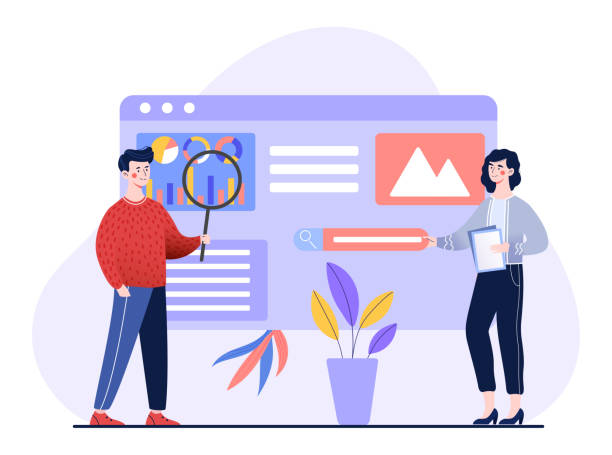
Search Engine Optimization (SEO) is an integral and vital component of a successful corporate website design in today’s world.
Even the best and most beautiful website will not be effective without being seen by its target audience and will not achieve its business objectives.
SEO means improving and elevating your website’s ranking in the organic search results of engines like Google, #Bing, and other search engines, which helps you attract more organic traffic.
The first and most important step in SEO is comprehensive and precise #keyword_research.
You need to identify the words and phrases that your target audience is most likely to use to find products, services, or information related to your field of work.
These keywords should be strategically and naturally incorporated into your website’s page titles, main texts, meta descriptions, image Alt tags, and URL addresses.
The second very important aspect is #technical_SEO, which addresses the website’s underlying structure.
This includes ensuring that your website is fully crawlable and indexable by search engine bots, has very high loading speed, and correctly and optimally uses an XML Sitemap and robots.txt file.
Also, ensuring the website’s full responsiveness for various devices is a critical factor for mobile SEO, which Google highly values.
The third fundamental pillar is #on-page_SEO, which focuses on user-visible content.
This includes optimizing content quality and relevance, correct use of heading tags (H1-H6) for content structuring, compelling meta descriptions, appropriate Alt Text for images for better understanding by search engines, and SEO-friendly URL structures.
High-quality, informative, and engaging content that answers user questions not only significantly improves SEO but also greatly enhances the user experience.
The fourth aspect is #off-page_SEO, which primarily refers to building high-quality and reputable backlinks from other websites.
Backlinks signal to search engines that your website possesses authority, expertise, and trustworthiness, which helps increase domain authority and site ranking.
To continuously improve #corporate_website_design_SEO, you should regularly update your content and use analytical tools like Google Analytics and Google Search Console to monitor SEO performance, identify new opportunities, and resolve potential issues.
This is a specialized #guide that significantly helps increase your website’s visibility in search results and attract targeted traffic.
The Importance of User Experience (UX) and User Interface (UI) in Corporate Website Design

User Experience (UX) and User Interface (UI) are two main and complementary pillars in the success of any corporate website design, often mistakenly used interchangeably, yet each plays a distinct and vital role in attracting and retaining users.
UI refers to the visual appearance and how the user interacts with the visual elements of the website; how buttons look, how colors are combined, how fonts are chosen, and where graphical elements are placed.
An attractive, modern, and professional UI makes your website appear pleasant, trustworthy, and professional to visitors, creating a positive first impression.
UX, however, goes beyond mere appearance and addresses how the user feels, their comfort, and efficiency when using the website.
This includes ease of use, efficiency in task completion, overall satisfaction, and the pleasure the user experiences from interacting with your website.
A strong UX means that users can easily and without any confusion or hindrance pursue their goals on your website, whether that goal is finding contact information, purchasing a product, or signing up for a newsletter.
For an #organizational_website, UX and UI are particularly important because they directly influence the initial perception of customers, partners, and even future employees of your brand.
A website with an inappropriate or unprofessional UI might question the company’s credibility and alienate potential customers.
Also, if the UX is poor and users cannot easily find the information they need, processes are complicated, or they have navigation difficulties, they will likely quickly leave the website and go to competitors’ websites.
Visually appealing and user-friendly interface design, coupled with a smooth and effortless user experience, significantly helps increase conversion rates, reduce bounce rates, and increase user time spent on the site.
This is not only highly beneficial for your business in terms of customer acquisition and sales but also sends positive and important signals to search engines, which can help improve your SEO ranking and increase your site’s visibility.
Therefore, in the process of #creating_a_company_website, strategic investment in precise UX/UI research and design should be made from the very beginning.
This includes building real user personas, meticulous user journey mapping, conducting usability testing with real users, and continuous feedback collection for subsequent improvements.
Remember, an excellent corporate website design must be both visually beautiful and engaging, and functionally completely practical and efficient, to provide the best experience for all visitors and achieve your business goals.
This is an important educational and specialized lesson in the field of #corporate_online_platform_development and its importance for long-term success.
Maintenance, Updates, and Continuous Security of a Corporate Website
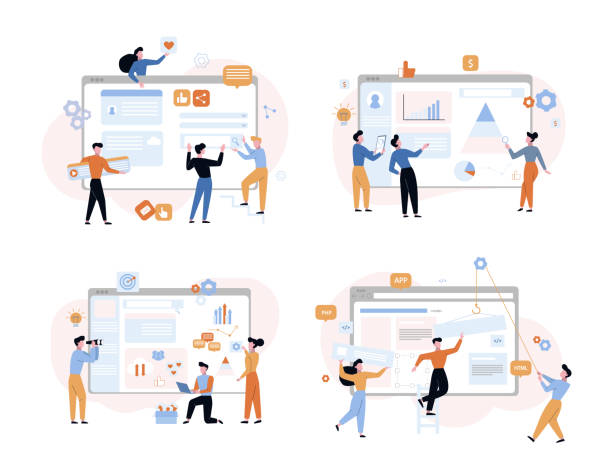
Corporate website design, contrary to some beliefs, is not a one-time process that ends with launch; rather, it initiates a period requiring continuous maintenance, updates, and constant attention to preserve optimal performance, stable security, and long-term efficiency.
After the initial launch, your website enters a vital and ongoing phase called maintenance, which guarantees its continued success.
The first and most important aspect in this phase is regular and periodic #content_updates.
Website content (including text, images, videos, and any other information) must be periodically reviewed, revised, and updated to provide accurate, fresh, relevant, and engaging information about your business to your audience.
This includes publishing new company news, adding information about new products and services, and writing informative and useful blog articles.
Fresh content not only appeals to users and encourages them to return but also significantly helps with your website’s SEO and ranking in search engines.
The second aspect is #technical_and_security_updates of the website, which is of high importance.
This includes regular updates to the Content Management System (CMS) such as WordPress or Drupal, all plugins, themes, and any other software or library upon which your website is built.
These updates often include security fixes (security patches), performance improvements, and the addition of new features.
Failure to perform necessary updates can make your website highly vulnerable to cyber-attacks, malware, and security vulnerabilities, exposing sensitive information to risk.
Installing and maintaining an SSL certificate, using a Web Application Firewall (WAF), conducting periodic penetration tests, and regular, automated backups of all website data and files are fundamental and vital security measures.
The third aspect is #website_performance_monitoring and analysis.
Continuous monitoring of page loading speed, uptime (site availability), and overall website performance using tools like Google Analytics and Google Search Console is absolutely vital.
Rapid identification and resolution of any performance or technical issues are essential to maintain a desirable user experience and prevent a drop in search engine rankings.
Fourth, #continuous_improvement based on user feedback and precise data analysis.
By examining user behavior, navigation patterns, and analysis results, you can identify your website’s strengths and weaknesses and optimize its various sections.
This includes changes to UI/UX, adding new features, or refining and optimizing content strategy so that the website always operates at peak efficiency.
This is important and specialized news for every company with an active website: continuous maintenance is the key to your #corporate_website’s long-term success in digital marketing and customer acquisition.
The development and maintenance of a #business_website is an ongoing and living process that requires constant attention.
| Maintenance Activity | Importance | Suggested Frequency |
|---|---|---|
| Content Updates | Continuous acquisition of new users and SEO improvement through fresh and relevant content | Weekly or monthly, depending on the type of business |
| Security Patches and Vulnerability Fixes | Protection against cyber-attacks, maintaining user trust, and preventing data loss | Immediately upon release of a new patch or discovery of a vulnerability |
| CMS and Plugin Updates | Performance improvement, adding new functionalities, and maintaining security against emerging threats | Monthly or quarterly, with careful compatibility checks |
| Full Site Backup | Ability to fully restore site information and functionality in case of any issue or attack | Daily for active sites, weekly for other sites |
| Performance Monitoring (Speed, Uptime) | Maintaining optimal user experience, preventing drops in search engine rankings due to poor performance | Daily or weekly with automated monitoring tools |
| Checking and Fixing Broken Links | Improving SEO by preventing 404 errors and enhancing user experience by ensuring access to information | Monthly or quarterly |
| Testing Forms and Core Functionalities | Ensuring correct operation of all user contact points and vital website processes | Monthly |
Common Mistakes in Corporate Website Design and How to Avoid Them

In the exciting and sometimes challenging journey of corporate website design, there are some common and recurring mistakes that, if you are unaware of them, can render all your efforts and investments fruitless and harm your business.
Awareness of these pitfalls and how to intelligently avoid them is crucial for ensuring the online success and digitalization of your company’s activities.
The first and perhaps most common mistake is #ignoring_the_target_audience and a lack of understanding of their needs.
Some companies design and build a website based solely on personal taste or their own internal ideas, without carefully considering the real needs, desires, and expectations of end-users and potential customers.
Always ask yourself: “What does my ideal customer want to see on my website, what information are they looking for, or what action do they want to take?”
The answer to this fundamental question is the basis of any successful design that leads to customer acquisition and retention.
The second mistake is #overly_complex_and_confusing_design.
A cluttered, disorganized website with difficult navigation and complex menus quickly confuses users, causing them to leave your website and go to competitors.
Simplicity, clarity, and minimalism in visual design and navigation structure are always the best approach, creating a positive user experience.
Overly dense content, unorganized images, or a chaotic layout can seriously harm the user experience.
The third point is the #lack_of_full_mobile_optimization, which is considered an unforgivable error in the present era.
In the current era, the vast majority of internet users browse through mobile devices (smartphones and tablets).
If your website is not responsive and does not display correctly on mobile, it not only provides a poor user experience but also severely reduces your SEO ranking in mobile search results.
This is a common mistake in #organizational_website_design that, unfortunately, is still overlooked by some businesses.
The fourth mistake is #ignoring_the_importance_of_SEO from the very beginning of the project.
SEO (Search Engine Optimization) should not be an afterthought or a stage added after design completion; rather, it should be fully considered from the initial stages of website design and development in information architecture, keyword selection, and content structure.
A #corporate_online_platform_development without a strong SEO strategy is like having a very beautiful shop on a dead-end street with no signpost.
The fifth mistake is the #lack_of_engaging_content_and_regular_updates.
A website with outdated, inaccurate, or boring and copied content cannot keep users engaged and quickly loses its credibility.
Remember that content is king; high-quality, fresh, unique, and informative content brings users back and also helps with SEO.
The sixth mistake is #slow_website_page_loading_speed.
Today’s users are very impatient, and every second of loading delay can mean losing a visitor and potential customer.
Optimizing image size, compressing code and scripts, and using a CDN (Content Delivery Network) are crucial for increasing speed.
The seventh item is the #absence_of_a_clear_and_specific_call-to-action (CTA).
After visiting your pages, users should clearly know what the next step is and what is expected of them.
This is a thought-provoking content that asks you: Are you or your company committing these mistakes in your #corporate_website_design process?
Avoiding these issues will help you achieve a successful and results-oriented corporate website design.
Are you worried about losing customers because you don’t have a professional e-commerce site?
Forget these worries with e-commerce website design by Rasaweb!
✅ Significant increase in sales and visitor-to-customer conversion rate
✅ Professional and user-friendly design that builds customer trust
⚡ Get a free consultation from Rasaweb
Measuring the Success of a Corporate Website and Key Performance Indicators
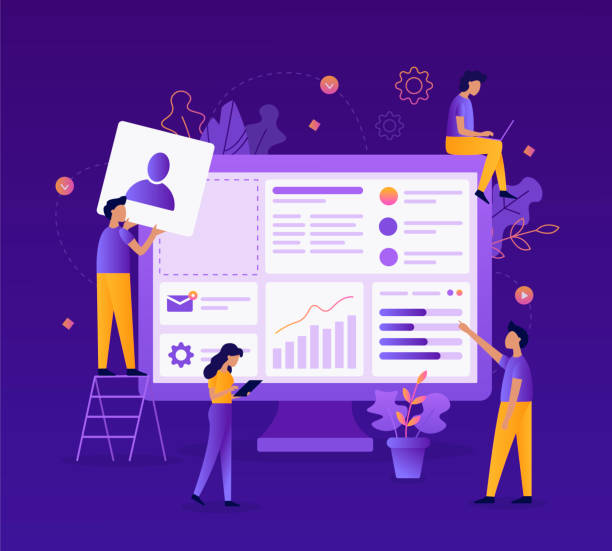
After a significant investment in the corporate website design process and its launch, the next crucial stage is the precise and continuous measurement of its success.
Without accurate evaluation and analysis of website performance, you cannot correctly understand whether your website is contributing to your business goals, whether your investment has yielded returns, and where optimization is needed.
Powerful analytical tools such as Google Analytics and Google Search Console play a pivotal and indispensable role in this process.
One of the very important Key Performance Indicators (KPIs) is #website_visitors or incoming traffic.
This indicates how many users have visited your website, but it’s not sufficient on its own.
You should also pay attention to #traffic_sources (e.g., organic search, social media, referrals from other sites, or advertising campaigns) and also #new_vs_returning_visitors, each indicating different aspects of success.
The next and crucial indicator is #bounce_rate.
A high bounce rate indicates that users have left your website after visiting a single page without navigating to other pages or interacting.
This could indicate irrelevant content, difficult navigation, unattractive design, or a poor user experience that needs investigation.
#Average_session_duration and #pages_per_session are also important indicators.
The higher these numbers, the more engaged users are with your content, and the more valuable your website has been to them.
For a #business_or_organizational_website, #conversion_rate is of high importance and perhaps the most critical KPI.
This rate measures what percentage of your visitors have performed the desired and targeted action (such as filling out a contact form, downloading a brochure, registering for a webinar, requesting a product demo, or making an online purchase).
Precisely defining conversion goals in Google Analytics helps you meticulously monitor and optimize this metric.
Furthermore, continuously monitoring the #ranking_of_your_main_keywords in search engines and the amount of organic traffic resulting from them indicates the success of your SEO strategy and visibility in search results.
Monitoring #site_speed_reports, #mobile_performance, and technical errors is also crucial for maintaining optimal user experience and SEO ranking.
By regularly and thoroughly analyzing these metrics and data, you can identify your website’s strengths and weaknesses and make data-driven decisions for its continuous improvement, ultimately leading to an increase in Return on Investment (ROI) from your #corporate_website_design.
This is a deep, analytical, and educational analysis for evaluating the performance and optimization of your #company_website_development.
The Future of Corporate Website Design; New Trends and Upcoming Changes
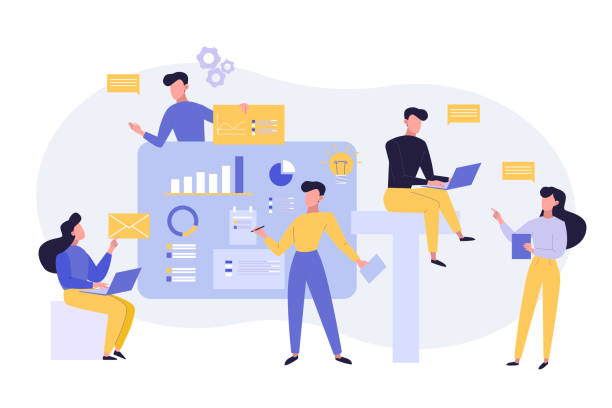
The world of corporate website design and online platform development is constantly evolving and progressing, and anticipating and understanding future trends is considered vital and essential for any business seeking to maintain a competitive advantage and stay ahead.
A deep understanding of these changes helps you prepare your #corporate_website_design for the future and stay ahead of your competitors.
One of the most prominent and impactful future trends is the integration of #Artificial_Intelligence (AI) and #Machine_Learning (ML) into website user experience.
AI can enable websites to provide fully personalized content relevant to each user’s past interests and behavior, activate much smarter and more efficient chatbots, and even automate aspects of website design and layout.
This can elevate the user experience to an entirely new level of interaction and satisfaction.
Another important trend is the expansion of #Voice_User_Interfaces (VUIs) and the increasing importance of #voice_search.
With the significant growth in the use of voice assistants like Siri, Google Assistant, and Alexa, optimizing websites to respond to voice commands and queries and present information in this manner will become increasingly important.
This necessitates a change in how content and keywords are structured.
#Virtual_Reality (VR) and #Augmented_Reality (AR) technologies also hold great potential to fundamentally change how users interact with websites and online platforms.
Companies can use AR to allow their customers to virtually view products in their own real environment (e.g., seeing furniture in their living room before purchasing) or offer immersive virtual tours of their offices, factories, or projects with VR.
These technologies can provide an entertaining, engaging, and memorable experience for visitors.
#Minimalist_Design and #Content-First_Approach are also enduring trends that continue to evolve.
Websites are moving towards greater simplicity in design, intelligent use of ample white space, and maximum emphasis on high-quality visual and textual content to convey information more effectively, quickly, and unambiguously.
Cybersecurity will also gain increasing importance as threats become more complex.
Employing more advanced security protocols, protecting user data, and serious attention to privacy in accordance with global regulations will be fundamental requirements for #corporate_online_platform_development.
Finally, #sustainability_and_green_websites are also becoming an ethical and important trend.
This includes optimizing code, images, and servers for lower energy consumption and reducing the website’s digital carbon footprint.
These news and predictions indicate that the future of #company_website_development is full of innovations that will transform the digital experience.
Preparing for these changes will keep you at the forefront of competition and long-term success and position you as a leading #organizational_website.
Frequently Asked Questions
| Question | Answer |
|---|---|
| What is corporate website design? | Designing and developing a professional website for a company or organization to introduce products, services, history, contact information, and establish communication with customers and stakeholders. |
| Why does a company need a corporate website? | To increase credibility and trust, provide 24/7 access for customers, more effective marketing and advertising, introduce services and products to a wider audience, and improve customer communication. |
| What are the main features of a good corporate website? | Responsive design (mobile-compatible), high loading speed, simple and attractive user interface, high-quality and up-to-date content, strong security, and communication features (like a contact form). |
| What stages does the corporate website design process usually include? | Includes planning and information gathering, graphic design (UI/UX), coding and development, content entry, testing and optimization, and finally launch and support. |
| How long does it take to design a corporate website? | The duration varies depending on the project’s complexity, number of pages, requested features, and client cooperation, but usually ranges from a few weeks to several months. |
And other advertising services of Rasaweb Advertising Agency
Smart Customer Journey Map: A fast and efficient solution for campaign management focusing on custom programming.
Smart Custom Software: Designed for businesses seeking to increase click-through rates through SEO-driven content strategy.
Smart Digital Advertising: A combination of creativity and technology to boost sales through SEO-driven content strategy.
Smart Brand Identity: Professional optimization for customer behavior analysis using an SEO-driven content strategy.
Smart Digital Advertising: Professional optimization for improving SEO ranking using custom programming.
And over a hundred other services in internet advertising, advertising consultation, and organizational solutions
Internet Advertising | Advertising Strategy | Advertorials
Resources
Why Does Your Company Need a Modern Website?
10 Important Features in Corporate Website Design
The Role of User Experience (UX) in Corporate Websites
SEO Benefits for Corporate Websites
💡 Rasaweb Afarin Digital Marketing Agency is your partner on the path to achieving digital success. From custom website design to SEO optimization and advertising campaign management, we offer innovative solutions for your business growth.
📍 Tehran, Mirdamad Street, next to Bank Markazi, Kazeroun Jonoubi Alley, Ramin Alley No. 6
